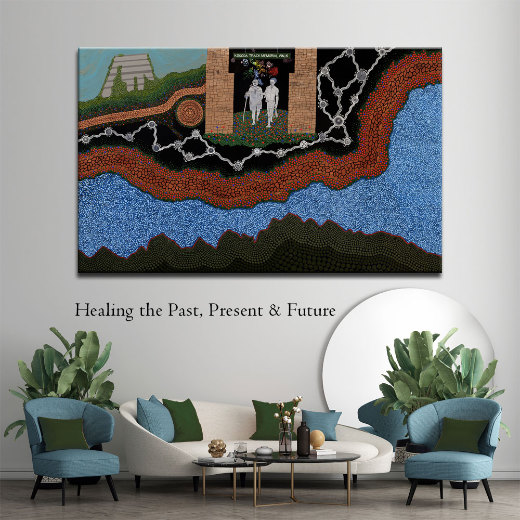ANZAC Research Institute
ARTWORK TITLE
BRIEF
Concord Hospital has recently completed part of its Redevelopment, with an emphasis on aged care services and rehabilitation.
To celebrate and note the history of the ANZAC Research Institute and Concord Hospital, the painting should depict the history of care and research on the Concord campus, with a focus on the future
opportunities the partnership enables. Continuing into the future, the ANZAC Research Institute and Concord Hospital aim to provide greater outcomes for patients and the community and improve
overall quality of life. The painting will reflect these aims and include the history of Aboriginal and Torres Strait Islanders that served as part of the ANZAC service. The final art piece will create a greater sense of community amongst Concord Hospital staff and the ANZAC Research Institute staff, as well as engage the communities that they serve.
STORY
The ANZAC Research Institute’s role is to provide better care and health outcomes on behalf of veterans and their community.
There is a close association with the Kokoda Track, with Concord Hospital having it’s very own Kokoda Memorial Trail, with a bronze statue of the famous photo (taken by New Zealand photographer George Silk) of a Papuan (Hanua) Man Raphael Oimbari leading wounded soldier Private George Whittington from the battle field to an aid station from the Kokoda Track.
Oimbari, was one of 14 Hanuan men that volunteered to help take food, medical supplies and ammunition to the front line for the ANZAC’s, these men were affectionately known as Fuzzy Wuzzy Angels.
In this artwork, we see Oimbari and Whittington, immortalised in the centre of the artwork, walking through a set of stone gates, on a bed of blue and red poppies. These gates stand at the beginning of Concord Hospital’s Kokoda track memorial walk, The bed of poppies represent fallen ANZAC’s and also the Aboriginal and Torres Strait Island service men and women that have frequented the ANZAC Institute and Concord Hospital over the past 80 years.
The bottom of the artwork is a series of mountain valleys and peaks, covered in a thin row of red poppies. This represents the elevations of the Kokoda Track, and the difficult pathways of which the ANZAC’s had fought against the Japanese.
The blue dot work above represents two things. Firstly, the obvious one, the sky above the mountain range, secondly, it represents water. The flow of water represents healing, and this is what the ANZAC Research Institute and Concord Hospital both represent.
Directly above this blue section is another pathway of broken ground bordered by blue and red poppies. This is an aerial view of the Kokoda track, but also represents the journey of broken veterans, on a journey of healing. It is a long journey, but is possible through the help of all the wonderful staff at the ANZAC Research Institute and Concord Hospital. The Poppies again representing the Aboriginal & Torres Strait Island Communities.
Above this section lies a black area, that has a number of meeting places and journey lines in white, these meeting places are surrounded by Aboriginal symbols for people, there are 140 in total, these represent the number of International authors who have published research articles and papers that have been written by the ANZAC Research Institute over the years. The journey lines continue off the top right of the artwork, this represents the ongoing journey and development by the ANZAC Research Institute to better serve not only it’s veterans but also community and staff for a brighter future for all.
Directly below the Kokoda Memorial Track Walk Sign is a series of coloured dots, this coincides with the journey lines below and represents the ANZAC Research Institute’s published papers and articles. The size of the circles represent the number of publications. Where there are more circles, there are more authors involved. The different colours represent the main groupings of authors.
Top left of the artwork is an aerial view of a section the Kokoda Memorial Track Walk and the surrounding waterways that border it. It is again filled with red and blue poppies, the blue poppies representing TSI service men and women, and the red poppies, Aboriginal servicemen and women.
Coming together, the whole artwork tells the story of 80 years of Concord Hospital’s association as a veteran’s Hospital and in more recent times the development of the ANZAC Research Institute, providing important research and development for services to better help and understand all the difficulties faced by veterans. It also tells the story of how this institute has had a global impact on many other health service industries.


